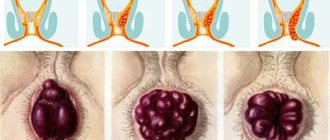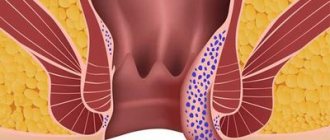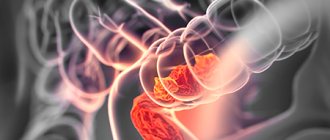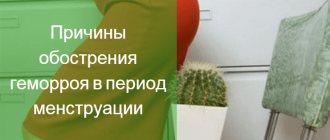Home » Hemorrhoids » External hemorrhoids: treatment
Sign up for a consultation with a proctologist for the treatment of hemorrhoids for 3,500 rubles and receive a treatment prescription within 30 minutes for 1 appointment
Find out what day you need to make an appointment to get a consultation without a queue.
Experience 44 years 73 operations per month 876 operations per year 171 reviews Author of 73 scientific papers Has 9 patents 6,818 requests per month
Call
A common proctological disease is called external hemorrhoids. The pathology is diagnosed in both young people and the elderly. Moreover, hemorrhoidal cones often appear in children. The disease is characterized by varicose veins in the anal area. Hemorrhoids form and rapidly increase in size. Upon palpation, neoplasms can be easily detected.
Every fourth patient suffers from external hemorrhoids. According to medical statistics, males are more prone to developing proctological disease. As a rule, most men work physically, and as a result, the functioning of the gastrointestinal tract is disrupted and anal fissures appear. Hemorrhoids progress quickly, so doctors advise starting treatment as early as possible to reduce the rehabilitation period.
Often external hemorrhoids develop in parallel with internal ones. We are talking about combined hemorrhoids, which is not so easy to cure. Lack of timely treatment leads to venous thrombosis and damage to the cavernous veins. Hemorrhoids are a multifactorial disease and are accompanied by obstructed outflow of venous blood in the hemorrhoidal plexuses.
How to cure external hemorrhoids? Specialists from the private proctology center “Proctologist 81” will answer this question for you. Doctors of the highest category will consult you at any convenient time, refer you to diagnostic tests of the body and prescribe effective treatment. With the help of modern equipment, the disease will be detected even in the early stages.
Acute hemorrhoids - what is it and how does it manifest?
Acute hemorrhoids are a condition in which a sudden exacerbation of the chronic form of the disease occurs. Proctologists consider this phenomenon dangerous and requiring urgent specialized help. The main symptoms by which an exacerbation of hemorrhoids can be identified are as follows:
- intense throbbing or twitching pain in the anus, which intensifies when sitting on a hard surface, coughing, during and after bowel movements;
- swelling of hemorrhoids - both internal and external hemorrhoids increase, the nodes fall out of the anus, become dense and become cyanotic;
- bleeding that occurs after a hemorrhoid ruptures and provides temporary relief from symptoms.
In most cases, the acute form of hemorrhoids is accompanied by inflammation of the nodes. The beginning of this process is indicated by redness of the mucous membrane of the rectum (if hemorrhoids are internal), anal folds and the skin over the external hemorrhoid.
In this case, additional symptoms appear in the form of swelling of the anus, a slight increase in temperature and fever (this occurs very rarely).
If treatment for the acute form of the disease is not started on time, the inflammatory process spreads to the surrounding tissues, including subcutaneous tissue. In this case, there is a high risk of purulent paraproctitis.
When inflammation spreads to the subcutaneous tissue, the pain spreads to the entire perineum. Exudate is released from the anus, which causes additional irritation.
How to treat external hemorrhoids in men
To treat external hemorrhoids in men, conservative treatment methods are used in most cases. Medications can relieve the patient from painful syndromes and complications. Medicines help normalize blood circulation, increase the firmness and elasticity of veins.
External hemorrhoids are removed in critical cases. We are talking about the third and fourth stages of proctological disease. Held:
- laser coagulation,
- latex ligation of hemorrhoids,
- sclerotherapy using special drugs that are injected into the anus.
Each patient is assigned individual treatment. The duration of rehabilitation and treatment depends on the patient’s condition and the size of the hemorrhoids.
A popular method of treating hemorrhoids in men is called cryodestruction. The affected area is treated with liquid nitrogen. Ultra-low temperatures allow you to painlessly remove hemorrhoids in a short time. The tumors die and fall out on their own after a few hours. The advantage of this therapy is that it is bloodless and effective. Relapses occur extremely rarely.
Causes of acute hemorrhoids
Several phenomena lead to exacerbation of the acute form of hemorrhoids, which can also be called the causes of the disease:
- Systematic stool disorder. Prolonged diarrhea, like constipation, creates favorable conditions for swelling of hemorrhoids, their loss and inflammation.
- Excessive physical activity. Lifting weights causes an increase in intra-abdominal pressure and blood flow to the rectum. As a result, internal and external hemorrhoids swell.
- Prolonged standing or sitting position, which leads to stagnation of blood in the pelvis. As a result of this process, the nodes become enlarged and blood clots form in them.
- Eating foods that stimulate blood flow to the pelvic organs and can cause bowel problems. These include smoking and pickling, marinades, hot spices, and alcoholic beverages.
In women, exacerbation of hemorrhoids often occurs during pregnancy, since fetal pressure causes stagnation of blood in the rectum. Often the disease appears after childbirth.
In order to choose the right method for treating exacerbation of hemorrhoids, the doctor will have to determine the causes of its occurrence.
Understanding the mechanism of the disorder will help eliminate the main provoking factors and prevent their occurrence in the future.
Signs of prolapse of cavernous nodes
The symptoms of proctological disease increase gradually, so at the initial stage of the pathological process the patient may not be aware of the presence of hemorrhoids.
The appearance of bloody discharge in the stool indicates the progression of the disease
The patient can independently diagnose the disease based on the following signs:
- Sensation of a foreign body in the rectal canal (the patient begins to strain the sphincter muscles to straighten the prolapsed sinus).
- Feeling of incompleteness after bowel movement (bowel movement does not bring relief because there is a foreign body in the rectum).
- Itching in the perineal area (excessive secretion of mucus irritates the skin, pathogenic microflora may join, which will increase inflammation).
- Bleeding from the anal canal (in most cases observed with internal cavernous nodes or external trauma).
- Pain syndrome (with exacerbation of the chronic process, the intensity of pain increases, especially with external nodes).
The severity of the clinical picture depends on the stage of the disease and the individual characteristics of the organism.
If the patient has at least one symptom of the disease, it is necessary to immediately visit a specialist, he will determine the stage and nature of the pathology and select the appropriate treatment.
Treatment methods for acute hemorrhoids
If signs of exacerbation of hemorrhoids appear, treatment should begin as quickly as possible. The list of therapeutic methods is determined based on the type of hemorrhoids, its stage, and existing complications (thrombosis or strangulation). In addition to conservative treatment (medicines, diet, folk remedies), surgical intervention is used.
The choice of treatment method is influenced by factors such as the presence of hemorrhoidal strangulation and the duration of this phenomenon, the presence of thrombosis, and much more.
Drug therapy
For acute hemorrhoids, local medications in the form of ointments, suppositories and gels are used. Oral agents are used when vascular walls are weakened and there is a high risk of blood clots, as well as in the presence of an inflammatory process. Medicines are selected based on the existing symptoms. These can be anti-inflammatory, painkillers, hemostatic agents. For greater effect, complex medications are prescribed for local use:
- Posterisan Forte;
- Proctosan;
- Procto-Glyvenol;
- Anuzol;
- Relief Ultra;
- Gepatrombin and others.
The listed suppositories for acute hemorrhoids are prescribed when the nodes are located inside the rectum.
If bleeding occurs, blood thinning drugs are not prescribed. In such situations, preference should be given to products with an antimicrobial effect in order to prevent infections from entering the wounds.
If there is an exacerbation of external hemorrhoids, proctologists give preference to medications in the form of ointments and gels:
- Heparin ointment;
- Troxevasin;
- Proctosedyl;
- Levomekol;
- Bezornil;
- Hepatrombin G;
- Aurobin and others.
They are applied directly to the external hemorrhoids and on a gauze pad and left overnight.
In case of an acute attack of hemorrhoids, oral medications are also prescribed: Phlebodia, Ginkor Forte, Movalis, Detralex and others. They fight the cause of the disease - varicose veins, strengthen the walls of blood vessels, and increase their tone. They can also be used to prevent exacerbations of hemorrhoids.
In extreme cases, when the pain becomes unbearable and the drugs mentioned above do not help eliminate the symptoms and relieve inflammation, suppositories with adrenaline and novocaine blockade are used.
Diet
The first thing to do in case of acute hemorrhoids is recommended by all proctologists without exception - to adjust your diet. The patient is recommended to follow a strict diet, the purpose of which is to normalize stool and eliminate constipation and diarrhea. The following products are excluded from the menu:
- fresh milk;
- legumes;
- mushrooms;
- pickles and marinades;
- smoked meats;
- baked goods;
- fatty fish and meats;
- spices;
- any fast food;
- alcohol, coffee, strong tea, carbonated drinks.
The basis of the diet is cereals, vegetables and fruits. They contain a lot of fiber, which helps normalize stool. Fermented milk products also help restore stool: kefir, fermented baked milk, natural yogurt without additives, cottage cheese. The diet also involves including eggs (no more than 2 per day) and lean meat (poultry breast, beef). It is useful to include laxative foods in the menu.
Meals should be regular: the number of meals reaches 5-6 per day, the portion size is average. It is advisable to drink plenty of water between meals. The minimum volume of liquid is 2-2.5 liters. These can be compotes, juices, herbal teas or plain water.
If, if you are prone to constipation, the diet does not help improve bowel movements, proctologists recommend using mild laxatives, for example, Regulax, Duphalac, Fitomucil or Mucofalk.
Video with a specialist’s opinion on nutrition for hemorrhoids:
Surgery
Surgical intervention for hemorrhoids is prescribed after overcoming the exacerbation, however, in case of severe bleeding, pinched nodes and thrombosis of hemorrhoidal veins, it can be performed urgently.
The choice of how to treat hemorrhoids with surgical methods depends on the stage of development of the disease:
- In the early stages, minimally invasive interventions are used - ligation with latex rings, photocoagulation or laser therapy, cryodestruction, disarterization and sclerosis.
- At stages 2, 3 and subsequent, when the nodes have reached a large size and began to fall out of the rectum, a Milligan-Morgan hemorrhoidectomy or Longo operation is performed.
- In the presence of thrombosis of hemorrhoids, thrombectomy is used.
Before surgery, it is necessary to undergo a course of conservative therapy. The use of topical and oral agents continues after surgery.
Folk remedies
In case of exacerbation of hemorrhoids, treatment at home is more preferable; only in case of pinched nodes and thrombosis, hospitalization is necessary. Left without the constant supervision of a specialist, most patients use additional means to eliminate the symptoms of hemorrhoids:
- sitz baths with herbal decoctions (chamomile, calendula);
- lotions and compresses with oils (sea buckthorn, butter, etc.) and garlic;
- microenemas with herbal decoctions (chamomile, oak bark, calendula);
- self-made rectal suppositories (from potatoes, ice, sea buckthorn oil, propolis);
- homemade ointments with sea buckthorn with oil and propolis, potato juice.
The effectiveness of most folk remedies used for treatment at home is questionable. They are recommended to be used only in combination with medications. Relying only on home remedies is dangerous, since they poorly relieve symptoms and have virtually no positive effect on blood vessels and do not prevent the further progression of hemorrhoids.
Important! Before using folk remedies, you should consult your doctor. Some home remedies have serious contraindications.
Symptoms of the disease at different stages
With hemorrhoids, prolapse of nodes occurs at the stage of a chronic process, 5-6 years after the onset of the disease. The symptom is characteristic of the progression of the condition, when the first stage gives way to the second. At an early stage, the prolapsed node extends beyond the boundaries of the rectal canal only with significant loads, strong straining, or excessive coughing. Since the intestinal muscular system is able to maintain the closure of the sphincters, the cavernous sinuses return to their original position on their own. With constant reduction of the cavernous sinuses, they may become damaged and become infected, which increases the risk of complications.
The third stage is characterized by the prolapse of hemorrhoids, regardless of the intensity of the load; this condition can be observed even with moderate walking or slight stress. The nodules can no longer correct themselves; the patient has to resort to digital reduction. Dystrophic changes in the soft tissues and intestinal mucosa progress, which leads to a disorder in the functional ability of the anal sphincter.
At the final stage of the disease, complete destruction of the muscular and ligamentous apparatus of the rectal canal occurs, they are replaced by connective tissue. Manual reduction at this stage is impossible without severe bleeding. Constantly prolapsing cavernous sinuses are injured during walking, hygiene procedures, and bowel movements, which causes the soft tissues to become denser and rougher. There is a risk of pathogenic microflora joining, which causes an infectious process in the patient’s body.
Prolapse of the cavernous sinuses can be accompanied by either the release of a single node or a whole cluster of hemorrhoidal formations.
What are the dangers of acute hemorrhoids - complications
In the absence of timely treatment, exacerbation of hemorrhoids is fraught with serious complications:
- thrombosis of hemorrhoidal plexuses;
- inflammation and infection of the subcutaneous tissue with the formation of a purulent cavity (purulent paraproctitis);
- rupture of the vascular wall and heavy bleeding;
- necrosis of the mucous membrane of the rectum and blood vessels with prolonged strangulation of the hemorrhoid.
Each of these conditions cannot be eliminated by conservative methods, so the patient is prescribed surgical intervention.
The difference between hemorrhoids and rectal prolapse
Most patients diagnosed with cavernous sinuses are interested in the question of how to distinguish hemorrhoids from rectal prolapse.
A distinctive feature of rectal prolapse is the exit of the distal intestine to the outside
With rectal prolapse, there is a complete exit of the lower part of the intestine beyond the boundaries of the anus. The cause of prolapse is strong mobility of the rectum and weakness of the intestinal muscular system. It begins to stretch and eventually falls out. The mucous membrane of the prolapsed section undergoes destructive changes, it becomes swollen, red or bluish, and significantly increases in volume. In case of timely treatment of reduction of the rectal area, blood circulation can be restored. Without the necessary treatment measures, the mucous membrane becomes necrotic.
The similarity of the signs of rectal prolapse with the symptoms of hemorrhoids:
- long-term retention of feces;
- discharge of blood from the rectal canal;
- pain during bowel movements.
You can recognize rectal prolapse from hemorrhoids by the following criteria:
- Due to an increase in the intensity of physical activity.
- While coughing or sneezing.
- The prolapsed segment of the rectum can be reset with a finger.
- Exit of the segment can occur without straining.
At home, it is difficult to determine prolapse of the rectal segment from prolapse of nodes due to hemorrhoids, since to clarify the diagnosis you need to undergo special diagnostic tests, so you need to visit a proctologist. This is due to the fact that the treatment tactics for both diseases are radically different. In case of improper therapy, the course of the pathological process can be complicated.
Prevention of exacerbations of hemorrhoids
Exacerbations of hemorrhoids can be prevented by a set of preventive measures, which include:
- following a diet aimed at stabilizing stool;
- physical activity - if the work is sedentary, you should get up every hour and do a warm-up;
- avoiding excessive physical activity, avoiding heavy lifting;
- perineal hygiene after defecation with cool water.
Those who regularly perform a set of special exercises, which are demonstrated in the following video clip, can also avoid exacerbations.
It is very important for prevention and competent treatment of chronic hemorrhoids, aimed at restoring blood vessels. If an exacerbation does occur, you should not try to cope with it yourself. It is better to consult a proctologist with this problem.
Diagnostic methods
Diagnosing the last stages of the pathological process is not difficult, since cavernous formations around the anal area are visible to the naked eye. They have a unique structure and color.
Diagnosis of the initial stage of hemorrhoids is difficult, so the specialist prescribes additional research methods
Algorithm for diagnosing hemorrhoids:
- Proctological examination. The specialist determines the condition of the cavernous plexuses, the presence of cracks in the anal sphincter area, and signs of bleeding.
- Palpation. Establishing the degree of prolapse of nodes, the possibility of their reduction, determining the degree of strength of the anal sphincter by irritating the skin around the rectal area.
- Intrarectal examination. The proctologist uses his fingers to determine the size of the nodes in the rectum, assess the level of pain and the strength of the sphincter closure.
- Endoscopic examination. Anoscopy and sigmoidoscopy are special techniques that allow us to examine pathological changes in the upper parts of the rectum.
- Detection of concomitant intestinal diseases (colonoscopy).







